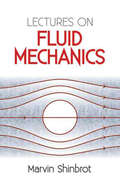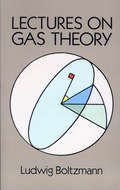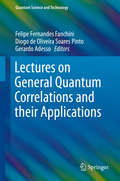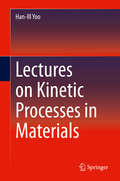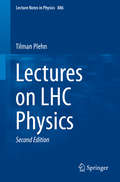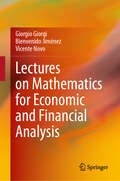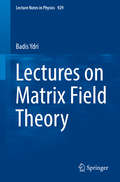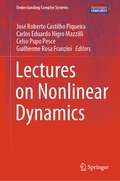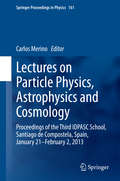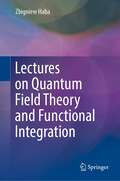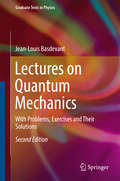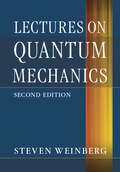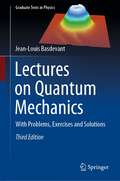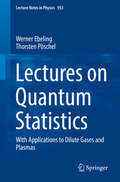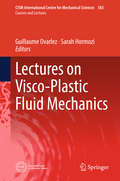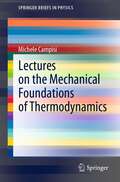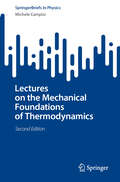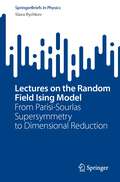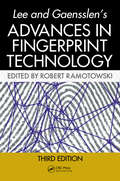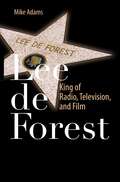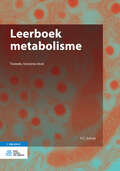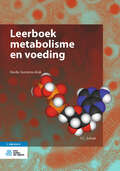- Table View
- List View
Lectures on Fluid Mechanics (Dover Books on Physics)
by Marvin ShinbrotA readable and user-friendly introduction to fluid mechanics, this high-level text is geared toward advanced undergraduates and graduate students. Topics include a derivation of the equations of fluid motion from statistical mechanics, classical theory, and a portion of the modern mathematical theory of viscous, incompressible fluids, with considerable attention to the Navier-Stokes equations. 1973 edition.
Lectures on Gas Theory (Dover Books On Physics Series)
by Ludwig BoltzmannOne of the great masterpieces of theoretical physics, this classic work contains a comprehensive exposition of the kinetic theory of gases that is still relevant today, nearly 100 years after its first publication. Although the modifications of quantum mechanics have rendered some parts of the work obsolete, many of the topics dealt with still yield to the classical-mechanics approach outlined by Boltzmann; moreover, a variety of problems in aerodynamics, nuclear reactors, and thermonuclear power generation are best solved by Boltzmann's famous transport equation.The work is divided into two parts: Part I deals with the theory of gases with monatomic particles, whose dimensions are negligible compared to the mean free path. Topics include molecules as elastic spheres and as centers of force, external forces and visible motions of the gas and the repelling force between molecules. Part II covers van der Waals' theory, the principles of general mechanics needed for a gas theory, gases with compound molecules, derivation of van der Waals' equation by means of the virial concept, theory of dissociation and supplements to the laws of thermal equilibrium in gases with compound molecules.Combining rigorous mathematical analysis with pragmatic treatment of physical and chemical applications, Lectures on Gas Theory was the standard work on kinetic theory in the first quarter of the 20th century.
Lectures on General Quantum Correlations and their Applications
by Felipe Fernandes Fanchini Diogo de Oliveira Soares Pinto Gerardo AdessoThis book presents a distinctive way of understanding quantum correlations beyond entanglement, introducing readers to this less explored yet very fundamental aspect of quantum theory. It takes into account most of the new ideas involving quantum phenomena, resources, and applications without entanglement, both from a theoretical and an experimental point of view. This book serves as a reference for both beginner students and experienced researchers in physics and applied mathematics, with an interest in joining this novel venture towards understanding the quantum nature of the world.
Lectures on Graph Theory: Insights into Feynman Diagrams (Lecture Notes in Physics #1035)
by Ray D. SameshimaThis book introduces foundational topics such as group theory, fields, linear algebra, matrix theory, and graph theory, providing readers with the essential background needed to understand Feynman diagrams and their integral representations. The book highlights Feynman's parametrization as a central tool for studying Feynman integrals, starting with the traditional momentum representation. Schwinger and Lee-Pomeransky parametrizations are covered in a supplementary chapter. Readers will develop a clear understanding of the mathematical properties and practical applications of these techniques, with a particular emphasis on Feynman’s approach. Advanced topics such as integration-by-parts identities and intersection number theory are explored in the final chapter, offering readers a gateway to key mathematical structures. The prerequisites are minimal—only a basic familiarity with algebra and calculus is recommended. The content begins with introductory concepts and gradually progresses to more advanced material, ensuring a balanced learning curve. Practical examples throughout the book reinforce the main ideas, allowing readers to apply what they’ve learned and deepen their understanding as they move through the material.
Lectures on Kinetic Processes in Materials
by Han-Ill YooThis book provides beginning graduate or senior-level undergraduate students in materials disciplines with a primer of the fundamental and quantitative ideas on kinetic processes in solid materials. Kinetics is concerned with the rate of change of the state of existence of a material system under thermodynamic driving forces. Kinetic processes in materials typically involve chemical reactions and solid state diffusion in parallel or in tandem. Thus, mathematics of diffusion in continuum is first dealt with in some depth, followed by the atomic theory of diffusion and a brief review of chemical reaction kinetics. Chemical diffusion in metals and ionic solids, diffusion-controlled kinetics of phase transformations, and kinetics of gas-solid reactions are examined. Through this course of learning, a student will become able to predict quantitatively how fast a kinetic process takes place, to understand the inner workings of the process, and to design the optimal process of material state change.Provides students with the tools to predict quantitatively how fast a kinetic process takes place and solve other diffusion related problems;Learns fundamental and quantitative ideas on kinetic processes in solid materials;Examines chemical diffusion in metals and ionic solids, diffusion-controlled kinetics of phase transformations, and kinetics of gas-solid reactions, among others;Contains end-of chapter exercise problems to help reinforce students' grasp of the concepts presented within each chapter.
Lectures on LHC Physics
by Tilman PlehnWhen trying to apply the solid knowledge of quantum field theory to actual LHC physics - in particular to the Higgs sector and certain regimes of QCD - one inevitably meets an intricate maze of phenomenological know-how, common lores and other, often historically grown intuition about what works and what not. These lectures are intended to be a brief but sufficiently detailed primer on LHC physics that will enable graduate students and any newcomer to the field to find their way through the more advanced literature as well as helping them to start work in this very timely and exciting field of research.
Lectures on Mathematics for Economic and Financial Analysis
by Giorgio Giorgi Bienvenido Jiménez Vicente NovoThis book offers a comprehensive yet approachable introduction to essential mathematical concepts, tailored specifically for undergraduate and first-year graduate students in Economics and Social Sciences. Based on lectures delivered at the University of Pavia's Department of Economics and Management, and also in UNED’ Department of Applied Mathematics in Madrid, it aims to equip students with the mathematical tools necessary to better understand their courses in economics and finance, where math is applied directly. Unlike texts focused on formalized topics like Mathematical Economics or Operations Research, this book presents basic mathematical principles and methods that are immediately relevant to students. With a clear, accessible approach, it includes numerous examples, some with economic applications, to illustrate key concepts and make them easier to grasp. The authors have carefully chosen proofs that are straightforward and beneficial for students to encounter, offering an introduction to important proof techniques without overwhelming complexity. The book also provides a select bibliography, allowing readers to explore topics in greater depth if desired. Drawing on years of teaching experience, the authors have created a valuable resource that serves as both a foundation and a practical guide for students navigating the mathematical aspects of economics and social science courses.
Lectures on Matrix Field Theory
by Badis YdriThese lecture notes provide a systematic introduction to matrix models of quantum field theories with non-commutative and fuzzy geometries. The book initially focuses on the matrix formulation of non-commutative and fuzzy spaces, followed by a description of the non-perturbative treatment of the corresponding field theories. As an example, the phase structure of non-commutative phi-four theory is treated in great detail, with a separate chapter on the multitrace approach. The last chapter offers a general introduction to non-commutative gauge theories, while two appendices round out the text. Primarily written as a self-study guide for postgraduate students - with the aim of pedagogically introducing them to key analytical and numerical tools, as well as useful physical models in applications - these lecture notes will also benefit experienced researchers by providing a reference guide to the fundamentals of non-commutative field theory with an emphasis on matrix models and fuzzy geometries.
Lectures on Nonlinear Dynamics (Understanding Complex Systems)
by José Roberto Castilho Piqueira Carlos Eduardo Nigro Mazzilli Celso Pupo Pesce Guilherme Rosa FranziniThis book presents a compilation of lectures delivered at the São Paulo School of Advanced Sciences on Nonlinear Dynamics, categorized into four groups: parametric resonance, nonlinear modal analysis and model reduction, synchronization, and strongly nonlinear dynamics. Interwoven seamlessly, these groups cover a wide range of topics, from fundamental concepts to practical applications, catering to both introductory and advanced readers. The first group, consisting of chapters 1 and 2, serves as an introduction to the theory of parametric resonance and the dynamics of parametrically excited slender structures. Chapters 3, 4, and 5 form the second group, offering insights into normal forms, nonlinear normal modes, and nonlinear system identification. Chapters 6 and 7 delve into asynchronous modes of structural vibration and master-slave topologies for time signal distribution within synchronous systems, respectively, representing the third group. Finally, the last four chapters tackle the fourth group, exploring nonlinear dynamics of variable mass oscillators, advanced analytical methods for strong nonlinear vibration problems, chaos theory, and dynamic integrity from the perspectives of safety and design. This book harmoniously combines theoretical depth and practical relevance to provide a comprehensive understanding of nonlinear dynamics.
Lectures on Particle Physics, Astrophysics and Cosmology
by Carlos MerinoThis volume gathers the content of the courses held at the Third IDPASC School, which took place in San Martiño Pinario, Hospederia and Seminario Maior, in the city of Santiago de Compostela, Galiza, Spain, from January 21st to February 2nd, 2013. This school is the annual joint program of the International Doctorate Network in Particle Physics, Astrophysics, and Cosmology (IDPASC). The purpose of the school series is to present doctoral students from different universities and laboratories in Europe and beyond with a broad range of the latest results and current state of the art in the fields of Particle Physics, Astrophysics, and Cosmology, and to further introduce them to both the questions now posed by the potentials of physics and to challenges connected with current and future experiments - in particular, with the newly available energy ranges. Following these guidelines, the content of this third edition of the IDPASC School was jointly planned by the Academic Council and by the network's International Committee, whose members ensure every year its timely formulation, keeping up with the constant evolution of these fields. The program covers a balanced range of the latest developments in these fields worldwide, with courses offered by internationally acknowledged physicists on the Basic Features of Hadronic Processes, Quantum Chromodynamics, Physics and Technology of ALICE, LHCb Physics-Parity Violation, the Higgs System in and beyond the Standard Model, Higgs Searches at the LHC, Theory and Experiments with Cosmic Rays, Numerical Methods and Data Analysis in Particle Physics, Theoretical Cosmology, and AdS/CFT Correspondence. Most of these courses were complemented by practical and discussion sessions.
Lectures on Quantum Field Theory and Functional Integration
by Zbigniew HabaThis book offers a concise introduction to quantum field theory and functional integration for students of physics and mathematics. Its aim is to explain mathematical methods developed in the 1970s and 1980s and apply these methods to standard models of quantum field theory. In contrast to other textbooks on quantum field theory, this book treats functional integration as a rigorous mathematical tool. More emphasis is placed on the mathematical framework as opposed to applications to particle physics. It is stressed that the functional integral approach, unlike the operator framework, is suitable for numerical simulations. The book arose from the author's teaching in Wroclaw and preserves the form of his lectures. So some topics are treated as an introduction to the problem rather than a complete solution with all details. Some of the mathematical methods described in the book resulted from the author's own research.
Lectures on Quantum Mechanics
by Jean-Louis BasdevantBeautifully illustrated and engagingly written, Twelve Lectures in Quantum Mechanics presents theoretical physics with a breathtaking array of examples and anecdotes. Basdevant's style is clear and stimulating, in the manner of a brisk lecture that can be followed with ease and enjoyment. Here is a sample of the book's style, from the opening of Chapter 1: "If one were to ask a passer-by to quote a great formula of physics, chances are that the answer would be 'E = mc2'. . . . There is no way around it: all physics is quantum, from elementary particles, to stellar physics and the Big Bang, not to mention semiconductors and solar cells. "
Lectures on Quantum Mechanics
by Paul A. DiracThe author of this concise, brilliant series of lectures on mathematical methods in quantum mechanics was one of the shining intellects in the field, winning a Nobel prize in 1933 for his pioneering work in the quantum mechanics of the atom. Beyond that, he developed the transformation theory of quantum mechanics (which made it possible to calculate the statistical distribution of certain variables), was one of the major authors of the quantum theory of radiation, codiscovered the Fermi-Dirac statistics, and predicted the existence of the positron.The four lectures in this book were delivered at Yeshiva University, New York, in 1964. The first, "The Hamiltonian Method," is an introduction to visualizing quantum theory through the use of classical mechanics. The remaining lectures build on that idea. "The Problem of Quantization" shows how one can start with a classical field theory and end up with a quantum field theory. In "Quantization on Curved Surfaces," Dirac examines the possibility of building a relativistic quantum theory on curved surfaces. He deduces that it is not possible, but it should be possible on flat surfaces. In the final lecture, "Quantization on Flat Surfaces," he concludes that "we can set up the basic equations for a quantum theory of the Born-Infeld electrodynamics agreeing with special relativity, but [not] with general relativity." Physics and chemistry students will find this book an invaluable addition to their libraries, as will anyone intrigued by the far-reaching and influential ideas of quantum mechanics.
Lectures on Quantum Mechanics
by Steven WeinbergNobel Laureate Steven Weinberg combines his exceptional physical insight with his gift for clear exposition to provide a concise introduction to modern quantum mechanics. Ideally suited to a one-year graduate course, this textbook is also a useful reference for researchers. Readers are introduced to the subject through a review of the history of quantum mechanics and an account of classic solutions of the Schrödinger equation, before quantum mechanics is developed in a modern Hilbert space approach. The textbook covers many topics not often found in other books on the subject, including alternatives to the Copenhagen interpretation, Bloch waves and band structure, the Wigner-Eckart theorem, magic numbers, isospin symmetry, the Dirac theory of constrained canonical systems, general scattering theory, the optical theorem, the 'in-in' formalism, the Berry phase, Landau levels, entanglement and quantum computing. Problems are included at the ends of chapters, with solutions available for instructors at www. cambridge. org/9781107028722.
Lectures on Quantum Mechanics: With Problems, Exercises and Solutions (Graduate Texts in Physics)
by Jean-Louis BasdevantBeautifully illustrated and engagingly written, Twelve Lectures in Quantum Mechanics presents theoretical physics with a breathtaking array of examples and anecdotes. Basdevant’s style is clear and stimulating, in the manner of a brisk lecture that can be followed with ease and enjoyment. Here is a sample of the book’s style, from the opening of Chapter 1: "If one were to ask a passer-by to quote a great formula of physics, chances are that the answer would be ‘E = mc2’…. There is no way around it: all physics is quantum, from elementary particles, to stellar physics and the Big Bang, not to mention semiconductors and solar cells."
Lectures on Quantum Statistics: With Applications to Dilute Gases and Plasmas (Lecture Notes in Physics #953)
by Werner Ebeling Thorsten PöschelMost of the matter in our universe is in a gaseous or plasma state. Yet, most textbooks on quantum statistics focus on examples from and applications in condensed matter systems, due to the prevalence of solids and liquids in our day-to-day lives. In an attempt to remedy that oversight, this book consciously focuses on teaching the subject matter in the context of (dilute) gases and plasmas, while aiming primarily at graduate students and young researchers in the field of quantum gases and plasmas for some of the more advanced topics. The majority of the material is based on a two-semester course held jointly by the authors over many years, and has benefited from extensive feedback provided by countless students and co-workers. The book also includes many historical remarks on the roots of quantum statistics: firstly because students appreciate and are strongly motivated by looking back at the history of a given field of research, and secondly because the spirit permeating this book has been deeply influenced by meetings and discussions with several pioneers of quantum statistics over the past few decades.
Lectures on Visco-Plastic Fluid Mechanics (CISM International Centre for Mechanical Sciences #583)
by Guillaume Ovarlez Sarah HormoziThe book is designed for advanced graduate students as well as postdoctoral researchers across several disciplines (e.g., mathematics, physics and engineering), as it provides them with tools and techniques that are essential in performing research on the flow problems of visco-plastic fluids. The following topics are treated: analysis of classical visco-plastic fluid modelsmathematical modeling of flows of visco-plastic fluidscomputing flows of visco-plastic fluidsrheology of visco-plastic fluids and visco-plastic suspensionsapplication of visco-plastic fluids in engineering sciencescomplex flows of visco-plastic fluids.
Lectures on the Mechanical Foundations of Thermodynamics (SpringerBriefs in Physics)
by Michele CampisiThis brief provides a modern pedagogical exposition of the mechanical approach to statistical mechanics initiated by Boltzmann with his early works (1866-1871). Despite the later contribution by Helmholtz, Boltzmann himself (1884-1887), Gibbs, P. Hertz, and Einstein, the mechanical approach remained almost unknown to the modern reader, in favour of the celebrated combinatorial approach, developed by Boltzmann himself during his probabilistic turn (1876-1884). The brief constitutes an ideal continuation of a graduate course of classical mechanics and requires knowledge of basic calculus in many dimension (including differential forms), thermodynamics, probability theory, besides Hamiltonian mechanics. The cornerstone of the whole presentation is the ergodic hypothesis. Special attention is devoted to Massieu potentials (the Legendre transforms of the entropy) which are most natural in statistical mechanics, and also allow for a more direct treatment of the topic of ensemble equivalence.
Lectures on the Mechanical Foundations of Thermodynamics (SpringerBriefs in Physics)
by Michele CampisiThis book provides a modern pedagogical exposition of the mechanical approach to statistical mechanics initiated by Boltzmann with his early works (1866–1871). Despite the later contribution by Helmholtz, Boltzmann himself (1884–1887), Gibbs, P. Hertz, and Einstein, the mechanical approach remained almost unknown to the modern reader, in favour of the celebrated combinatorial approach, developed by Boltzmann himself during his probabilistic turn (1876–1884). The brief constitutes an ideal continuation of a graduate course of classical mechanics and requires knowledge of basic calculus in many dimensions (including differential forms), thermodynamics, and probability theory, besides Hamiltonian mechanics. The cornerstone of the whole presentation is the ergodic hypothesis. Special attention is devoted to Massieu potentials (the Legendre transforms of the entropy) which are most natural in statistical mechanics and also allow for a more direct treatment of the topic of ensemble equivalence. In this second edition, a chapter is added that addresses the long-debated question of how the second law of thermodynamics can be reconciled with mechanics, by using modern methods of non-equilibrium statistical mechanics.
Lectures on the Random Field Ising Model: From Parisi-Sourlas Supersymmetry to Dimensional Reduction (SpringerBriefs in Physics)
by Slava RychkovThis book is about the Random Field Ising Model (RFIM) – a paradigmatic spin model featuring a frozen disordering field. The focus is on the second-order phase transition between the paramagnetic and ferromagnetic phases, and the associated critical exponents. The book starts by summarizing the current knowledge about the RFIM from experiments, numerical simulations and rigorous mathematical results. It then reviews the classic theoretical works from the 1970’s which suggested a property of dimensional reduction – that the RFIM critical exponents should be the same as for the ordinary, non-disordered, Ising model of lower dimensionality, and related this an emergent Parisi-Sourlas supersymmetry. As is now known, these remarkable properties only hold when the spatial dimensionality of the model is larger than a critical dimension. The book presents a method to estimate the critical dimension, using standard tools such as the replica trick and perturbative renormalization group, whose result is in agreement with the numerical simulations. Some more elementary steps in the derivations are left as exercises for the readers. This book is of interest to researchers, PhD students and advanced master students specializing in statistical field theory.
Lectures on the Theory of Water Waves
by Thomas J Bridges Mark D. Groves David P. NichollsIn the summer of 2014 leading experts in the theory of water waves gathered at the Newton Institute for Mathematical Sciences in Cambridge for four weeks of research interaction. A cross-section of those experts was invited to give introductory-level talks on active topics. This book is a compilation of those talks and illustrates the diversity, intensity, and progress of current research in this area. The key themes that emerge are numerical methods for analysis, stability and simulation of water waves, transform methods, rigorous analysis of model equations, three-dimensionality of water waves, variational principles, shallow water hydrodynamics, the role of deterministic and random bottom topography, and modulation equations. This book is an ideal introduction for PhD students and researchers looking for a research project. It may also be used as a supplementary text for advanced courses in mathematics or fluid dynamics.
Lee and Gaensslen's Advances in Fingerprint Technology
by Allan GawReflecting new discoveries in fingerprint science, Lee and Gaensslen‘s Advances in Fingerprint Technology, Third Edition has been completely updated with new material and nearly double the references contained in the previous edition. The book begins with a detailed review of current, widely used development techniques, as well as some older, histo
Lee de Forest
by Mike AdamsThe life-long inventor, Lee de Forest invented the three-element vacuum tube used between 1906 and 1916 as a detector, amplifier, and oscillator of radio waves. Beginning in 1918 he began to develop a light valve, a device for writing and reading sound using light patterns. While he received many patents for his process, he was initially ignored by the film industry. In order to promote and demonstrate his process he made several hundred sound short films, he rented space for their showing; he sold the tickets and did the publicity to gain audiences for his invention. Lee de Forest officially brought sound to film in 1919. Lee De Forest: King of Radio, Television, and Film is about both invention and early film making; de Forest as the scientist and producer, director, and writer of the content. This book tells the story of de Forest's contribution in changing the history of film through the incorporation of sound. The text includes primary source historical material, U.S. patents and richly-illustrated photos of Lee de Forest's experiments. Readers will greatly benefit from an understanding of the transition from silent to audio motion pictures, the impact this had on the scientific community and the popular culture, as well as the economics of the entertainment industry.
Leerboek metabolisme
by Frans C. SchuitMetabolisme of stofwisseling gaat over chemische reacties die brandstoffen omzetten in nuttige energie en bouwstenen vanuit de voeding opbouwen tot bestanddelen van het lichaam. Dit complexe gebeuren heeft grote invloed op gezondheid en ziekte en vormt daarom een onmisbaar onderwerp in de opleidingen geneeskunde, mondzorg en biomedische wetenschappen. Aan de ene kant is het belangrijk om te weten hoe het metabolisme normaal werkt en inspeelt op dagelijkse veranderingen in de voedingstoestand en fysische activiteit. Aan de andere kant zijn er specifieke stofwisselingsziekten maar ook complexe bijdragen van een veranderd metabolisme aan frequente ziekten zoals diabetes en kanker. De 2e herziene druk van Leerboek metabolisme bestaat uit twaalf hoofdstukken, verdeeld over twee gedeelten. Het eerste gedeelte bevat de kernleerstof en wordt ondersteund door 270 afbeeldingen, concrete leerdoelen en studeeraanwijzingen. Het tweede gedeelte gaat nader in op bepaalde onderwerpen en tast hierbij grenzen van wetenschappelijk verantwoorde vakkennis af, bespreekt de rol van pioniers in vroeger onderzoek, benoemt het belang hiervan voor huidige medische toepassingen en beschouwt het onderwerp vanuit de evolutieleer. Deze verdieping in de stof is herkenbaar gemaakt in gekleurde kaders en wordt ruim ondersteund door verwijzingen naar recente literatuur. De veelzijdige samenstelling van de informatie biedt studenten de mogelijkheid een leerpad te volgen dat bij de eigen interesse aansluit. Door de opzet fungeert het boek als een gids tijdens een reis naar het onafhankelijk en kritisch kunnen nadenken over een complex onderwerp. De speciaal voor deze druk ontwikkelde website met toetsvragen biedt de daarbij horende gebruiksvriendelijke verdieping en ondersteuning.
Leerboek metabolisme en voeding
by F.C. SchuitDit boek behandelt de belangrijkste aspecten van het menselijke metabolisme op een inzichtelijke manier. Het bespreekt de basisbegrippen, de complexe relatie tussen metabolisme en voeding en tussen metabolisme en ziektemechanismen. Het boek is bestemd voor studenten geneeskunde, mondzorg, farmacie en biomedische wetenschappen, hbo voeding en diëtetiek. De inhoud van het boek is verweven met een van de pijlers van de bachelorfase van de hiervoor vermelde opleidingen: de chemische basis van gezondheid en ziekte. Metabolisme gaat over chemische reacties die brandstoffen omzetten in nuttige energie en bouwstenen vanuit de voeding opbouwen tot bestanddelen van het lichaam. Het is belangrijk om te weten hoe het metabolisme normaal werkt en inspeelt op dagelijkse veranderingen in de voedingstoestand en fysische activiteit. Maar ook wat er speelt bij specifieke stofwisselingsziekten en de complexe bijdragen van een veranderd metabolisme aan frequente ziekten zoals diabetes en kanker.De derde herziene druk van Leerboek metabolisme en voeding bestaat uit twaalf hoofdstukken. De kernleerstof wordt ondersteund door 270 afbeeldingen, concrete leerdoelen en studeeraanwijzingen. In elk hoofdstuk staan ook verdiepende kaders over de grenzen van wetenschappelijk verantwoorde vakkennis, de rol van pioniers in vroeger onderzoek, het belang hiervan voor huidige medische toepassingen en beschouwingen uit de evolutieleer. Daarbij wordt steeds verwezen naar recente literatuur.Op de bijbehorende website zijn 300 toetsvragen, casussen en hot topics te vinden.
